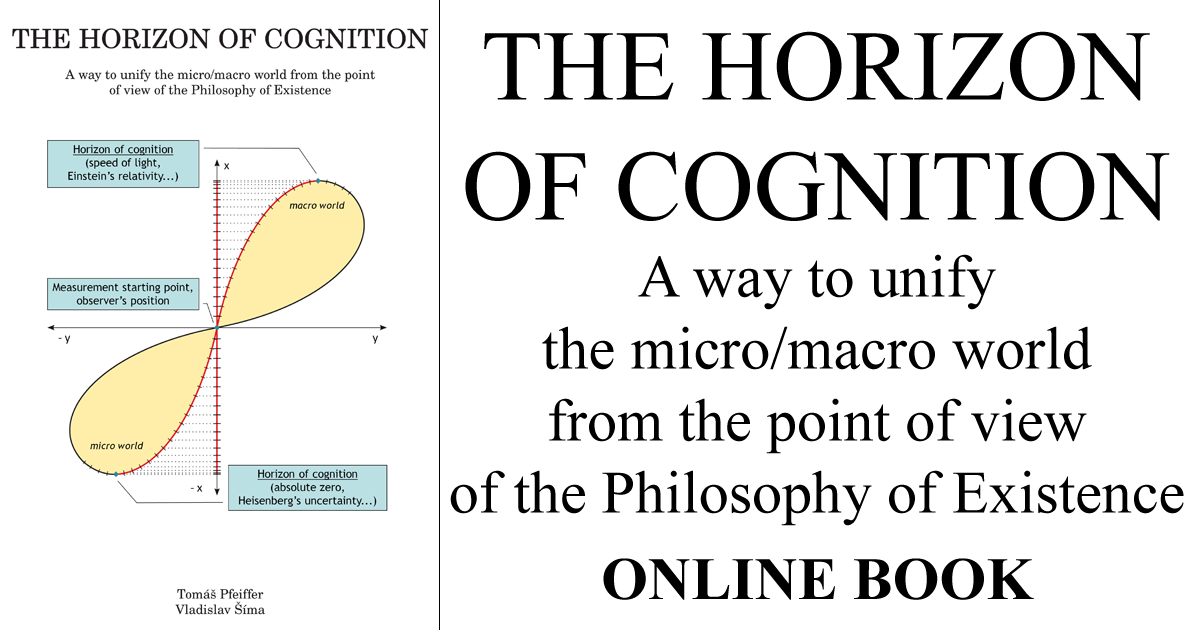Abstract
This publication presents an attempt to introduce unifying philosophical view of the current scientific research of the macro and micro worlds.
The ideas in this work are based on the Philosophy of Existence by the Czech philosopher Josef Zezulka [1]. Based on the philosophical observations of our world and Tomáš Pfeiffer’s (Josef Zezulka’s student) considerations, it can be concluded that all scientific knowledge/findings may be confined to and limited by the horizon of cognition1 , originating as a consequence of a curvature of the spacetime2 we perceive. This is related to the non-linear and uncertain3 manifestations of macro and micro objects4 that are, by their nature/character (interval), distant from the observer.
The states of objects observed at the horizon of cognition are indistinguishable5 , which leads to the quantisation of spacetime itself6. As a consequence, particles of matter (e.g. electrons) manifest themselves as waves and electromagnetic waves manifest themselves as particles (and we talk about them as photons). This manifests itself not only in the micro world but also in the macro world (which should either confirm or disprove future scientific observations).
By applying the observations of the Philosophy of Existence7 to cosmology8, we can understand the topology9 of our world as an infinite chain of self-contained and interconnected sub- and super-universes10, which, in all their possible levels of existence, create a shape, which we could philosophically describe as a dimensionless sphere11. We can hence explain all the power (force) manifestations as a result of the quadrupole12 resonance effect of the fractal structure of force13 centres that are independent of mass14.
All this could help us not only understand quantum mechanics and cosmological dynamics, but also provide a fundamental starting point for a future theory of everything.
The philosophical ideas and observations presented in this work suggest novel explanations of the effects connected to the well-known double-slit experiment and justify why a wave, spreading in our 3D/ three-dimensional space (representing a quantum/particle) suddenly “materializes” and transforms into a measurable energy at the point of interaction (during the photoelectric effect for instance). This publication offers a novel approach to understanding what light actually is and shows a path, which could lead towards clarifying the origin, structure and dynamics of our universe.
The philosophical ideas in this publication (if accepted and further developed by the scientific community) offer a novel philosophical–scientific path towards a unifying view of the world of atoms and the macroworld.
1The horizon of cognition is a newly introduced term, which is explained in the book „Spacetime + Gravity“ [2], and in this book in chapter 2.1. The horizon of cognition sets the limit of our cognition and beyond this limit, we cannot observe or measure anything.
2In General relativity [3], a spacetime curvature is described as an attribute of gravity. In our view, we understand the spacetime curvature (non-linearity) as a general attribute of our world, inseparably connected to the position of the observer (see chapter 2.1). As the distance between the observer and the observed object increases, the curvature increases and all objects (intervals) observed are burdened by a larger and larger measurement error (see Fig. 2.1, chapter 2.1).
3Our perception and description of the world usually occurs within the rectangular linear Euclidean spaces which we use for measuring of intervals. Using these Euclidean spaces in a curved spacetime causes the error of cognition (measurement) of the real interval size to increase, which also increases the level of uncertainty.
4Micro objects – objects the size of molecules, atoms, protons, electrons etc. The corresponding measurement units are for instance angstroms (1 angstrom = 10−10 m). Macro objects – objects close to the boundary of the observable universe, the corresponding measurement units are for instance light years (1 light year = 9, 45 × 1015 m).
5The term indistinguishable refers to the impossibility of exactly determining the physical state (in the micro world, for instance, simultaneous knowledge of the position and momentum) of the observed particle using the linear Euclidean space.
6Explained in chapter 2.3.
7According to the Philosophy of Existence, a philosophical observation is made spiritually and is based on merging with the investigated object, making it possible to understand the object’s true nature. Such observations can also be described as “visions”. Quite a few examples can be found, for instance, in [1].
8Cosmology is a scientific field which studies the origin, development and the structure of the entire Universe. See the chapter 1.4.
9Topology is a mathematical discipline devoted to studying space, general properties of space and the objects contained in space. It studies, for instance, compactness, connectedness and continuity.
10Explained in chapters 2.2 and 4.1.
11Current mathematics, which regards a point to be the only dimensionless object, is not able to either describe or explain the term “dimensionless sphere”. Therefore, for the time being (until a new mathematical aspect has been developed), the only way we can approach an understanding of the expression “dimensionless sphere”, is by employing a philosophical approach, as described in chapter 4.1.
12The quadrupole resonation (the resonation of four forces) can be regarded as the basic factor of cosmological dynamics. This is explained in chapter 4.4.
13The term Force/Power refers to the root mechanism through which dynamics enter our world (i.e. the root mechanism that causes something to happen and change). This mechanism can be manifested, for instance, in the form of known physical interactions.
14The term “force/power centres, independent of mass” (i.e. non-material) is introduced by the Philosophy of Existence based on observations (see chapter 4.4). This philosophical view does not correspond with the present scientific paradigm, which considers mass to be the primary cause of force/power (mass is primordial). According to the observations made by the Philosophy of Existence, it is the other way round: the force/power is always primordial and it is the mass that accumulates around (or is being repulsed from) the relative force/power centre.

